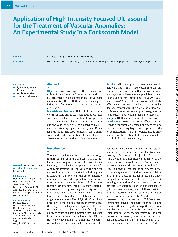摘要
Objective: We investigated the efficacy and safety of high-intensity focused ultrasound (HIFU) treatment in an animal model of vascular anomalies together with the energy efficiency relationship after varying exposure times and energy levels.
Materials and Methods: Hainanhui cockscombs were irradiated using a CZP therapeutic apparatus with ail optimal focus over different time periods. The changes in cuticular tissue of the cockscombs and the vascular regions were analyzed by TTC dye, H&E staining, light microscopy, and Doppler ultrasound. The rectal temperatures, weight, water and food consumption of the cocks were also measured during the whole experiment.
Results: H&E staining of the tissues and combs demonstrated similar histological findings, including vessel content, and thickness of the cuticular layers (ds). There were appreciable changes to the cockscombs after doses of 2.6 w x 200 s and 3.6 w x 120 s of HIFU exposure, with 100% effectiveness and 0.00% and 37.50% irreversible damage, respectively. There were no differences with regard to water consumption, weight, rectal temperature and foraging levels monitored pre- and post-HIFU administration of the two doses.
Conclusions: HIFU exposure is effective in destroying the vascular targeted anomaly with no skin burns, bleeding, large vessel ruptures or other complications. HIFU is feasible, noninvasive and safe for the treatment of vascular anomalies, but clinical trials are necessary.
- 出版日期2008-10
- 单位重庆医科大学
